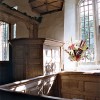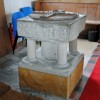The military significance of Shaston would not have been lost on Alfred the Great when he built the town in 880 AD; perched on a hilltop 700 feet above the plain approaching enemies could be seen while they were still miles away. There was, however, one major drawback: Shaston had no natural water supply.
Alfred was king of Wessex from 871 to 899 but no record exists of how this problem was overcome in the early days of the town. The existing wells were not adequate for the task and the sandstone rock being very porous possibly rainwater would have been collected and stored. Shaston’s demand for water increased as it grew in importance and became a place of pilgrimage attracting medieval tourists from far and wide. At some point the Corporation came to an agreement with the Lord of the Manor of Gillingham to draw water from the springs at Enmore Green, and carting water up to the town became a source of employment for many people.
Records dating back to 1518 tell how it was the custom on the Sunday after Holy Roode Day in May for the Mayor and Burgesses to lead the people of every parish within the borough of Shaston down to Enmore Green at one o’clock in the afternoon. There followed an hour of dancing led by a couple married during the year who were born and had lived all their days in the borough of Shaston.
At 2 o’clock the dancing ceased and the serious business of the afternoon got under way. Shaston’s greatest treasure in those days was its prize Besom, the Byzant. Made by a craftsman the Byzant looked somewhat like an umbrella gilded and mounted on a tall pedestal and decorated in the style of a May garland with valuable jewels lent for the occasion by some of Shaston’s better off citizens.
The precious Byzant was offered by the Mayor to the Lord of the Manor of Gillingham who accepted it as payment for the right to draw water from the spring. So valuable was the Byzant to the people of Shaston they had no intention of giving it away even for the right to draw water and they would take with them gifts with which to buy it back.
Tradition has it that the Mayor presented the Lord of the Manor with a pair of white gloves, two wheaten loaves, a calf’s head and a gallon of ale all for his own use. The Lord of the Manor would then hand the treasured Byzant back to the Mayor and invite him and all the people of Shaston to stay awhile. There followed a further hour of dancing before the Mayor and Burgesses led a procession of townsfolk back up Tout Hill to the town where the rest of the day was spent dancing and making merry.
After over four hundred years the ceremony ceased in May 1830, a time when many of the townsfolk were living in poverty and it was felt the considerable cost of staging the ceremony, with large sums being spent on feasting and drinking could not be justified. The minutes of a meeting on the 3rd of May 1830 read, “The Corporation resolved to approach Lord Grosvenor to dispense with the ceremony.” Lord Grosvenor (created Marquess of Westminster in 1831) was then the Lord of the Manor of Gillingham and he agreed to abolish the ceremony but he kept the borough’s Byzant.
The ceremony was briefly re-introduced in 1972 and by all accounts was an attraction that was a great success.
The Byzant found its way back to Shaston (nowadays known as Shaftesbury) in 1924 after the death of Lady Theodora Guest, daughter of the 2nd Marquess of Westminster. Her daughter, Miss Augusta Guest, presented it to the Shaftesbury Town Council. For many years it resided in the Mayor’s parlour but more recently its home has been the Shaftesbury Town Museum where it is on permanent display.



